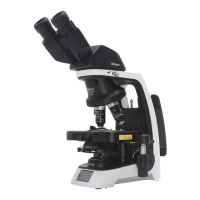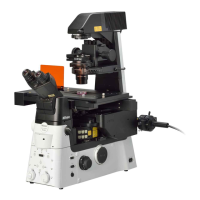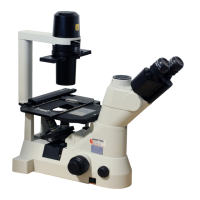Chapter 3 Individual Operations
125
Individual
Operations
ND filters in the motorized HG precentered fiber illuminator
The ND value of the ND filters in the motorized HG precentered
fiber illuminator can be controlled to adjust the brightness
incrementally.
Brightness can be adjusted in six steps, with the relative light
intensity cycling in the following order each time the switch is
pressed: 1 → 1/2 → 1/4 → 1/8 → 1/32 → 1 → ...
Use the CW/CCW button of the ergo controller connected to the
microscope to change the value of an ND filter of the motorized
HG precentered fiber illuminator. However, the function of these
buttons are not set to “drive the ND filter” as factory default.
Reallocate the button function using DS-L3.
(See “23 Operation on DS-L3” - “23.1 Setting Up the Microscope
- (3) Configuring the Button Functions” for details.), (See “20
Using the Ergo Controller”.)
Z Speed
FL cube
OBJ
Fl shutter
B/F/R
EPI all
XY Speed
Adjusting the ND filter value
PA__2x____Z:_____0.000um
UV-2B
'
C ____ND_ 1
'
C __EPI:C
ND value
Operation on DS-L3 (See “23.2 Controlling the Microscope”.)
For details on adjusting the ND value for the manual HG
precentered fiber illuminator, see the instruction manual for the
illuminator.
Aperture diaphragm
F. S T O P
A. STOP
EX. ADJ
The aperture diaphragm is used to adjust the numerical aperture
of the illumination system. Under epi-fluorescence microscopy, it
is also used to adjust the brightness of the image, as well as the
size of stray light.
Turning the aperture diaphragm lever of the epi-fluorescence
attachment changes the size of the aperture diaphragm.
Pushing in the lever opens the aperture diaphragm while pulling
it out closes it. Stopping down the aperture diaphragm reduces
stray light, but will also make the image darker. Conversely, a
larger aperture diaphragm size increases the brightness, but
may also increase the amount of stray light. For standard
epi-fluorescence microscopy, keep the diaphragm open, and
stop down as necessary to adjust the image brightness.
Be sure to center the aperture diaphragm of the
epi-fluorescence attachment as follows before use.
■ Centering the aperture diaphragm
(1) Close the shutter of the epi-fluorescence cube turret.
(2) Replace one objective on the nosepiece with the
centering tool.
(3) Under epi-fluorescence microscopy, focus on the
sample.
(4) Bring the centering tool into the optical path.
(5) Pull out the aperture diaphragm lever to stop down the
diaphragm.
(6) While watching the screen on the centering tool, turn the
aperture diaphragm centering screw with the provided
hex driver (2 mm across flats) to move the aperture
diaphragm image to the center of the screen. Be sure to
look straight at the screen.
1
2
A
λ
Adjusting and centering the aperture diaphragm
perture diaphragm
image
Centering tool
Aperture
diaphragm lever
Aperture diaphragm
centering screws
Diaph
agm
opens
Diaphragm
closes
